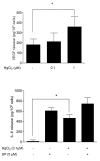Mercury induces inflammatory mediator release from human mast cells
- PMID: 20222982
- PMCID: PMC2850891
- DOI: 10.1186/1742-2094-7-20
Mercury induces inflammatory mediator release from human mast cells
Abstract
Background: Mercury is known to be neurotoxic, but its effects on the immune system are less well known. Mast cells are involved in allergic reactions, but also in innate and acquired immunity, as well as in inflammation. Many patients with Autism Spectrum Disorders (ASD) have "allergic" symptoms; moreover, the prevalence of ASD in patients with mastocytosis, characterized by numerous hyperactive mast cells in most tissues, is 10-fold higher than the general population suggesting mast cell involvement. We, therefore, investigated the effect of mercuric chloride (HgCl2) on human mast cell activation.
Methods: Human leukemic cultured LAD2 mast cells and normal human umbilical cord blood-derived cultured mast cells (hCBMCs) were stimulated by HgCl2 (0.1-10 microM) for either 10 min for beta-hexosaminidase release or 24 hr for measuring vascular endothelial growth factor (VEGF) and IL-6 release by ELISA.
Results: HgCl2 induced a 2-fold increase in beta-hexosaminidase release, and also significant VEGF release at 0.1 and 1 microM (311 +/- 32 pg/106 cells and 443 +/- 143 pg/106 cells, respectively) from LAD2 mast cells compared to control cells (227 +/- 17 pg/106 cells, n = 5, p < 0.05). Addition of HgCl2 (0.1 microM) to the proinflammatory neuropeptide substance P (SP, 0.1 microM) had synergestic action in inducing VEGF from LAD2 mast cells. HgCl2 also stimulated significant VEGF release (360 +/- 100 pg/106 cells at 1 microM, n = 5, p < 0.05) from hCBMCs compared to control cells (182 +/- 57 pg/106 cells), and IL-6 release (466 +/- 57 pg/106 cells at 0.1 microM) compared to untreated cells (13 +/- 25 pg/106 cells, n = 5, p < 0.05). Addition of HgCl2 (0.1 microM) to SP (5 microM) further increased IL-6 release.
Conclusions: HgCl2 stimulates VEGF and IL-6 release from human mast cells. This phenomenon could disrupt the blood-brain-barrier and permit brain inflammation. As a result, the findings of the present study provide a biological mechanism for how low levels of mercury may contribute to ASD pathogenesis.
Figures



Similar articles
-
Luteolin and thiosalicylate inhibit HgCl(2) and thimerosal-induced VEGF release from human mast cells.Int J Immunopathol Pharmacol. 2010 Oct-Dec;23(4):1015-20. doi: 10.1177/039463201002300406. Int J Immunopathol Pharmacol. 2010. PMID: 21244751
-
Murine mast cells exposed to mercuric chloride release granule-associated N-acetyl-beta-D-hexosaminidase and secrete IL-4 and TNF-alpha.J Allergy Clin Immunol. 1999 Jun;103(6):1108-14. doi: 10.1016/s0091-6749(99)70186-7. J Allergy Clin Immunol. 1999. PMID: 10359893
-
Rupatadine inhibits proinflammatory mediator secretion from human mast cells triggered by different stimuli.Int Arch Allergy Immunol. 2010;151(1):38-45. doi: 10.1159/000232569. Epub 2009 Aug 6. Int Arch Allergy Immunol. 2010. PMID: 19672095 Free PMC article.
-
Vascular endothelial growth factor (VEGF), mast cells and inflammation.Int J Immunopathol Pharmacol. 2013 Apr-Jun;26(2):327-35. doi: 10.1177/039463201302600206. Int J Immunopathol Pharmacol. 2013. PMID: 23755748 Review.
-
VEGF, substance P and stress, new aspects: a revisited study.J Biol Regul Homeost Agents. 2010 Jul-Sep;24(3):229-37. J Biol Regul Homeost Agents. 2010. PMID: 20846471 Review.
Cited by
-
Low-level mercury in children: associations with sleep duration and cytokines TNF-α and IL-6.Environ Res. 2014 Oct;134:228-32. doi: 10.1016/j.envres.2014.07.026. Epub 2014 Aug 28. Environ Res. 2014. PMID: 25173056 Free PMC article.
-
A review of research trends in physiological abnormalities in autism spectrum disorders: immune dysregulation, inflammation, oxidative stress, mitochondrial dysfunction and environmental toxicant exposures.Mol Psychiatry. 2012 Apr;17(4):389-401. doi: 10.1038/mp.2011.165. Epub 2011 Dec 6. Mol Psychiatry. 2012. PMID: 22143005 Free PMC article. Review.
-
Cytokine dysregulation in autism spectrum disorders (ASD): possible role of the environment.Neurotoxicol Teratol. 2013 Mar-Apr;36:67-81. doi: 10.1016/j.ntt.2012.07.006. Epub 2012 Aug 17. Neurotoxicol Teratol. 2013. PMID: 22918031 Free PMC article. Review.
-
Brief report: "allergic symptoms" in children with Autism Spectrum Disorders. More than meets the eye?J Autism Dev Disord. 2011 Nov;41(11):1579-85. doi: 10.1007/s10803-010-1171-z. J Autism Dev Disord. 2011. PMID: 21210299 Review.
-
Mast Cells Release Chemokine CCL2 in Response to Parkinsonian Toxin 1-Methyl-4-Phenyl-Pyridinium (MPP(+)).Neurochem Res. 2016 May;41(5):1042-9. doi: 10.1007/s11064-015-1790-z. Epub 2015 Dec 8. Neurochem Res. 2016. PMID: 26646004 Free PMC article.
References
-
- Geier DA, King PG, Sykes LK, Geier MR. A comprehensive review of mercury provoked autism. Indian J Med Res. 2008;128:383–411. - PubMed
Publication types
MeSH terms
Substances
LinkOut - more resources
Full Text Sources
Research Materials

